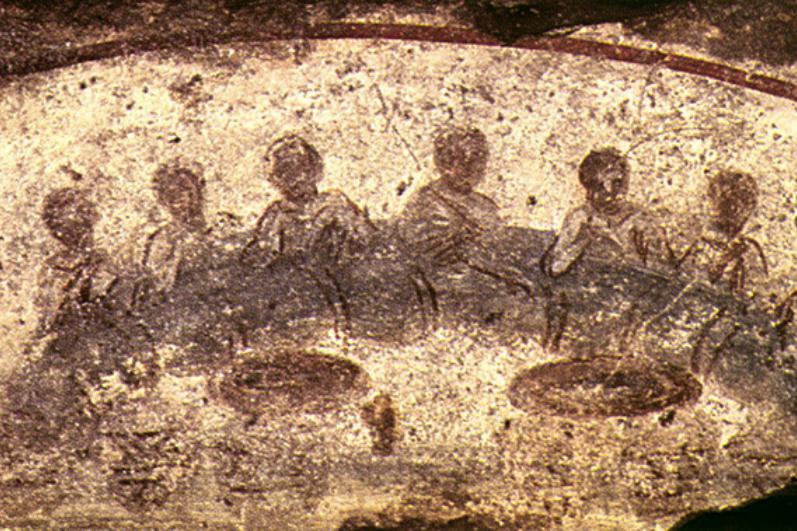Return to the agape meal: A practical step toward Eucharistic Revival
We believe that the Eucharist draws us into communion not only with Jesus, as we receive his body, but also with our fellow Catholics, who are members of his body. Nonetheless, most Catholics feel disconnected from one another, coming to their parish for Mass and leaving quickly afterward. It's hard for the Eucharist to become the center of our lives that way, let alone to build a vibrant culture through the parish.
In any age, a community will be strong when its members depend upon one another and build a common life together. Charity, above all else, characterized the early Christian community and caught the attention of pagans. Christians cared for one another and also did what they could to care for anyone in need. This charity became expressed in what was known as an "agape," a meal or feast to express the love of the community. Early Christian meals were prone to abuse, as we see in Paul's first letter to the Corinthians, where he said that rather than caring for the needy, some Christians indulged in excess. Likewise, Jude, in the 12th verse of his letter, spoke explicitly about the agape meal, telling Christians that their love feasts were blemished by looking first after themselves. These dynamics haven't changed much.
Not all was perfect in the early community, but they did strive for greater unity and charity by holding meals for this very purpose. The origin of the agape meal and its connection to the Eucharist are somewhat shrouded in mystery, but Anglican Vicar Alistair Stewart does his best to untangle them in a new scholarly book: "Breaking Bread: The Emergence of Eucharist and Agape in Early Christian Communities" (Eerdmans, 2023). To begin, he makes a fundamental distinction in defining the agape meal. Unlike the Eucharist, which focuses on communion with God, the agape focuses on communion with fellow Christians (9). What else can we say with relative clarity about the agape meal? Reviewing Stewart's painstaking analysis of ancient texts, I would describe it this way: the agape developed into a meal distinct from the Eucharist, whose purpose was to strengthen fellowship among Christians and to exercise charity in offering food to the needy, including those not present (chapter 2).
As funny as it sounds, coffee and doughnuts offer a scanty remnant of the agape meal, recognizing that after the celebration of the Mass, something further is needed for fellowship. This doesn't mean that coffee and doughnuts are the answer, for we all know that is not nearly enough, but it does preserve something of earlier traditions, such as offering blessed bread after Mass, as Eastern Catholics still do (and which was also practiced in the West in earlier days). Why not build upon this instinct and return to something like the agape meal? Christian community demands more than just one hour a week. We need to get to know one another, encourage and support each other, and focus on expressing charity within our local community. All of this could be done through regular fellowship meals.
Practically, there are a few ways we could go about this. First, rather than coffee and doughnuts, we could offer a potluck meal or brunch after Mass. People are already at church, and we could organize fellowship as an immediate extension of the communion received at Mass. Many people may baulk at the labor involved, as there are multiple Masses at most parishes, but, on the other hand, most everyone recognizes the need to do something to kickstart community in our parishes. These meals could be the basis for continuing education, organizing outreach to the poor to share parts of the meal, and simply feeling more connected.
Another approach would be to organize smaller groups in the home. This would more closely reflect the personal character of the ancient agape meal. This also could be on Sunday, as an expression of the ongoing celebration of the Lord's Day or on another day. These small groups could join together a few families as well as others in the parish of various ages and states of life. These meals could serve as the foundation for a Bible study, watching and discussing catechetical material and times of prayer. These agape-like meals would give Catholics the opportunity to invest in others stably over longer periods of time, providing concrete expression to Christian charity through a commitment to particular people in the parish. Rather than vague expressions of community and charity, we would have certain people to love and support, personalizing the community of our larger parishes.
If we focus more on loving one another in the Catholic community, making tangible our belief in the centrality of Christian charity, others may notice and want to join in. This would be a great way to instantiate our ongoing Eucharistic Revival through a continued expression of the unity and fellowship we find in the Mass.


















